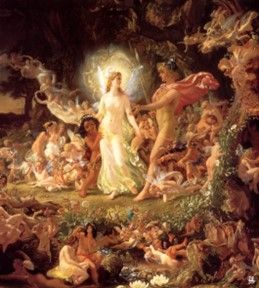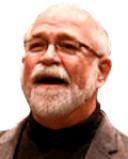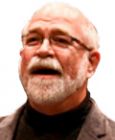Fear
Replacing Fear with Play at Halloween
Bewitched, bothered, and bewildered by spooky fairy rings.
Posted October 5, 2023 Reviewed by Hara Estroff Marano
Key points
- Our forebears often ascribed supernatural significance to natural events.
- They fervently believed in spirits that embodied their own human fears.
- Halloween, once fearful, is now played for laughs.
- Puritan New England personified fears in a belief in fantastic beings.
Fairy rings, the dark green circles that appear in lawns and meadows, occur more commonly deep in forests, as a fungus recycles decaying plant matter. Temporary fruiting bodies (some, like "death caps" and "destroying angels," are extraordinarily poisonous) may dot the turf above at the edge. Though the biological process is easily explained now, it was once profoundly mysterious.
The suddenness of their appearance, the toxicity of their fruit, the remoteness of their settings, and the strange symmetry they display invited folk storytellers to make sense of this ephemera.
In traditional societies that had no recourse to modern testable means or reliable prediction, creative explanation easily tracked toward the supernatural. Fairy rings that apparated in dim, out of the way places, vibrated with sacred overtones. In fact, in ancient and medieval Christendom, the wilderness that surrounded pockets of walled settlement was not the inspiring, healing sector it tends to be regarded today; it was instead the realm of the ungodly and the diabolical. A cursed meeting place suitable for fairies and witches.

Fairies and Fairy Rings
Echoing that ancient fear, we still call these fungal circles fairy rings. Older names, “pixie ring” and “elf circle,” are remnants of the rich mythology that grew around these natural phenomena.
Our image of fairies now is a product of 19th century literature and art. The fairy, ideally a beautiful, sometimes undraped seductress, la belle damme sans merci, would entrap and enchant the errant knight. Disney tamed the fairy as Tinkerbell, the pert, vulnerable sprite of the Peter Pan animations. But the fairy of a century and a half ago was more like Tolkien’s Galadriel, a warrior ruler of an elf kingdom, arresting in her beauty, mighty in her wisdom and power, but terrible in her vengeance.
Fairies Were Once Very Bad News
“Fairy” was once a more generic term, applying to all magical beings and to the realms they inhabited. One variety, solitary leprechauns with their tilted hats, twee in cute St. Patrick’s Day costumes now, were greedy, tricky rustics in the original.
Deceitful elves, another kind of fairy, would lure the unwary human with a fascinating dance into a time-dilated parallel universe where every minute comprised a long stretch in Earthly timekeeping. The most familiar of these victims, Rip Van Winkle, awoke with a long beard from a 20-year afternoon nap in his Kaatskill woods (“these fairy mountains”) after drinking with several grave, “odd looking personages”.
They could be human-sized, like Rip Van Winkle’s treacherous drinking chums, or diminutive, like gnomes and pixies. The smaller versions fit well into fairy circles. Mushroom caps proved just right for sitting on. The fungal ring framed a gathering place—a magic circle of celebration. Half-human mythical witches, and it is said, their real-life impersonators, would gather around the fairy ring and dance ecstatically and erotically in its dead center.
An Errand into Salem’s Wilderness
It is just such a clearing in the wicked forest that young Goodman Brown, Nathaniel Hawthorne’s hero, finds at its center a mystic, heretical, frightening rite conducted by the elders from nearby Salem. He barely escaped its enchantment.
In the real-life historical Salem, Massachusetts, of the late 17th century, a medieval outpost in colonial North America, Puritan colonists feared bewilderment—literally being lost in the ungodly wilds. Accordingly, Puritan divines stayed vigilant, keen to discover those allegedly bewitched.
Alas, they convicted and hanged 19 unfortunate victims of hallucination and convulsion. Five more died in custody. And one more of the unjustly accused succumbed under brutal questioning, crushed to death while begging for more weight to be piled on, in a suicide protest that would legally preserve his estate for his heirs.
For good measure, the Puritan divines also convicted and executed two dogs that they found to be possessed by devils.
Fungus Comes Full Circle
Recently, historians have advanced a startling hypothesis to account for the strange behavior of the persecuted people in Salem. The culprit? Bread made from moldy rye. Why would anyone eat bread made from moldy rye? Crop failures of the 1690s forced the Puritan colonists who lived at the edge of subsistence to make do or starve. The agent of spoilage? A fungus called calviceps purpurea that produces the hallucinogenic alkaloid, ergot. Ergot poisoning causes a variety of symptoms including sensations of crawling on the skin, delirium, and mania. Another mystery solved.
To the Puritan authorities, though, medieval thinkers who were victims not just of ignorance but of confirmation bias in the torture that extracted confessions, mental effects like these could only mean demonic possession.
Halloween Tamed
In modern America, just one holiday surpasses Halloween for household expenditure: Christmas. But no holiday beats Halloween for playfulness. We buy treats for trick-or-treaters. We buy mock-frightening costumes and get ourselves up as errant politicians, spoiled clergy, devils, and ghosts. We decorate and light our houses, spookily. We invite the neighbors in for spooky parties. We might dance to jolly, creepy music. But. We have nearly forgotten that the original pagan observance, in time Christianized opportunistically as All Hallow’s Eve, was meant to honor the departed and keep them at bay.
Whether pagan or Christian, our forebears fervently believed in spirits that embodied their own human fears, resentments, griefs, and anxieties. And they believed that at harvest time, at the end of October, when the sun turned the corner toward winter and when the moon was full and yellow, the membrane between the manifest world of the living and the unseen world of the dead was at its most permeable. Spirits could cross over to haunt the living.
Whether friendly or malign, and especially if they were malign, these spirits or fairies demanded honoring and propitiating. Or else.
References
Nathaniel Hawthorne, “Young Goodman Brown,” The New England Magazine (April,1835); Perry Miller, Errand into the Wilderness, The Belknap Press, (1956).
Susan Hatters Friedman, “Salem Witchcraft and Lessons for Contemporary Forensic Psychiatry,” Journal of the American Academy of Psychiatry and the Law Online, (June,
Mohammad Dabo, “U.S. Halloween Spending Set to Break Records at $12.2 BN,” Retail Insight Network, (October 2, 2023) https://www.retail-insight-network.com/news/us-halloween-spending-break-records/ , retrieved October 3, 2023.




